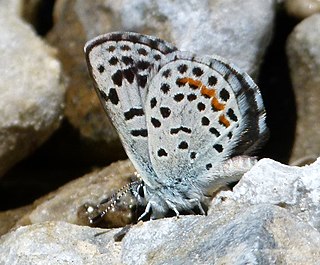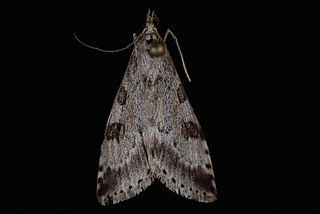
Udea is a genus of snout moths in the subfamily Spilomelinae of the family Crambidae. The genus was erected by Achille Guenée in 1845. The currently known 214 species are present on all continents except Antarctica. About 41 species are native to Hawaii.
Parahypenodes is a monotypic moth genus of the family Erebidae. Its only species, Parahypenodes quadralis, the masked parahypenodes moth, is found in the Canadian province of Quebec. Both the genus and species were first described by William Barnes and James Halliday McDunnough in 1918.

Grotella citronella is a species of moth in the genus Grotella, of the family Noctuidae. This moth is found in North America, including the Mojave Desert region of California. This species was first described by William Barnes and James Halliday McDunnough in 1916.

Idia diminuendis, the orange-spotted idia, is a litter moth of the family Erebidae. The species was first described by William Barnes and James Halliday McDunnough in 1918. It is found in North America from Wisconsin to Nova Scotia, south to Florida and Texas.
Idia julia, or Julia's idia, is a litter moth of the family Erebidae. The species was first described by William Barnes and James Halliday McDunnough in 1918. It is found from southern Canada south to Georgia and Texas.

Hyperstrotia pervertens, the dotted graylet, is a moth of the family Erebidae. The species was first described by William Barnes and James Halliday McDunnough in 1918. It is found in woodlands and forests of North America from Missouri to Nova Scotia, south to Florida and Texas. It is found in New Brunswick, Nova Scotia, Quebec and Ontario in Canada. In the United States, it has been recorded in Massachusetts, Iowa, New York and South Carolina.
James Halliday McDunnough was a Canadian linguist, musician, and entomologist best known for his work with North American Lepidoptera, but who also made important contributions about North American Ephemeroptera.
Oidaematophorus balsamorrhizae is a moth of the family Pterophoridae first described by James Halliday McDunnough in 1939. It is found in western North America, including California, Alberta, British Columbia and Washington.

Euphilotes ancilla, the Rocky Mountain dotted blue, is a species of butterfly of the family Lycaenidae. It is found from Washington south to California and southern Alberta and Saskatchewan south through the Rockies and high plains to Wyoming, Colorado, Utah, and northwestern New Mexico. The species was first described by William Barnes and James Halliday McDunnough in 1918.
Crambus awemellus is a moth in the family Crambidae. It was described by James Halliday McDunnough in 1921. It is found in North America, where it has been recorded from Alberta, Manitoba, Ontario and Quebec. The habitat consists of marl fens.
Loxocrambus awemensis is a moth in the family Crambidae. It was described by James Halliday McDunnough in 1929. It is found in North America, where it has been recorded from Manitoba, Alberta, Michigan and Ontario. The habitat consists of sand dunes.
Thaumatopsis floridella, the Floridian grass-veneer, is a moth in the family Crambidae. It was described by William Barnes and James Halliday McDunnough in 1913. It is found in North America, where it has been recorded from coastal areas in Florida, Georgia, Mississippi, New Jersey, North Carolina and South Carolina. It is also found in Cuba.
Pseudopyrausta santatalis is a moth in the family Crambidae. It was described by William Barnes and James Halliday McDunnough in 1914. It is found in the United States, where it has been recorded from southern Texas and Florida. It is also found in the West Indies and Mexico.
Atomopteryx solanalis, the carabid moth, is a moth in the family Crambidae. It is found in North America, where it has been recorded from Florida. The species was first described by William Barnes and James Halliday McDunnough in 1913.

Dasychira vagans, the variable tussock moth, is a moth of the family Erebidae. It is found in North America, where it has been recorded from Newfoundland to southern British Columbia in the north and North Carolina and Utah in the west. The habitat consists of forests, including coastal rainforests, high elevation mixed hardwood-conifer forests, oak woodlands and mixed hardwood forests. The species was first described by William Barnes and James Halliday McDunnough in 1913.
Udea berberalis is a moth in the family Crambidae. It was described by William Barnes and James Halliday McDunnough in 1918. It is found in North America, where it has been recorded from California.
Udea nordeggensis is a moth in the family Crambidae. It was described by James Halliday McDunnough in 1929. It is found in North America, where it has been recorded from Alberta.
Udea rusticalis is a moth in the family Crambidae. It was described by William Barnes and James Halliday McDunnough in 1914. It is found in North America, where it has been recorded from Arizona.
Udea sheppardi is a moth in the family Crambidae. It was described by James Halliday McDunnough in 1929. It is found in North America, where it has been recorded from Idaho, Maine, New York, Newfoundland and Quebec.

Udea washingtonalis, the Washington udea moth, is a moth in the family Crambidae. It was described by Augustus Radcliffe Grote in 1882. It is found in North America, where it has been recorded from Alaska, British Columbia, California, Montana and Washington.






